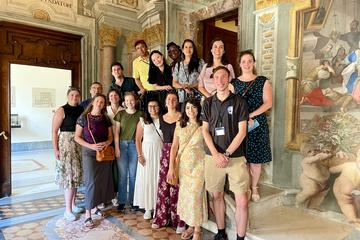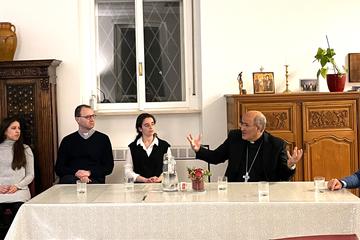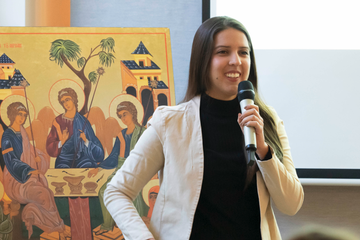In an opportunity to present the work of community members to an external audience, The Lay Centre held an “Open Day on Synodality” Nov. 12. The morning was rich in intellectual dialogue, held among Lay Centre residents and friends. Four scholars gave talks on topics directly or indirectly linked to the theme of synodality. The session was moderated by Loredana Fabijanic, an Angelicum doctoral student from Croatia.
An ordinand of the Church of England and Angelicum student, Clemency Flitter spoke about the historical concept of synodality in her tradition. Her analysis began in 1529, more than a year before King Henry VIII formally broke with the Catholic Church and instituted the Church of England, passing through the Colloquy of Marburg, a historical effort to unite the various nascent Protestant movements in Europe.
She gave concrete examples of how the Church of England has charted its own distinctive identity throughout its history, trying to find balance between the different traditions rooted both in Protestant and Catholic fields.
- Maria Teresa Ávila: Lived synodality and the concept of ‘bridge-people’
- Aljaž Krajnc: ‘Religious diversity is willed by God,’ a reflection on human fraternity
- Bruno Hermes: The Gospel groups of Amazonia’s Acre River
- Adrian Teodor Oancea: Synodality and autocephaly in the Eastern Orthodox Church
- WATCH ALL ‘DIES ACADEMICUS’ LECTURES ON OUR YOUTUBE PAGE
Flitter discussed the Book of Common Prayer, which has been used since 1549 and still liturgically unites the worldwide Anglican Communion today. Reviewed a few times, it was carefully worded to encompass, among other things, different theological understandings about the Eucharist. In this way, communion and common worship were preserved, although there was room for a certain amount of doctrinal difference.
The compromises struck in the Book of Common Prayer reflect the Church of England’s larger self-conception as a kind of “via media” or middle way, she said. Various figures contributed to the concept of the “via media” over the centuries, from Richard Hooker to John Henry Newman and the Oxford Movement.
Turning from history to our day, Flitter offered a few illustrations of the ways in which the Church of England’s big-tent approach remains alive and well.
At the highest level, the church is governed by a General Synod of three houses, all of which must agree to any significant changes in doctrine or practice. Private members, both lay and clerical, are allowed to make motions in the synod, and footage of synod meetings is available for anyone to watch.
At lower levels, different churches within the worldwide Anglican Communion may follow different rules regarding discipline and practice – such as the ordination of women to the priesthood and giving them roles of pastoral leadership.
This point illustrates synodal decision making in the Church of England, Flitter noted. When the Anglican Church decided to allow the ordination of women in the 1990s, some disagreed. The church as a whole reached a compromise: Although individual and local churches are obliged to accept the official position, they are not required to ordain women as priests. As well, neither parishes nor church communities are obliged to accept a woman as pastor.
Principles were established to facilitate this delicate balance between affirmation and respect. As Flitter acknowledged, however, such a compromise is difficult to maintain. A “big-tent” approach in the church requires that members with different theological views are in constant dialogue. If the church fails to be inclusive, Flitter said, it does not make itself bigger; it just makes the sacred table shared by its members smaller.
Contributed:
Filip Veber
Joseph Tulloch


